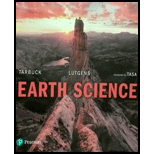Browse All Chapters of This Textbook
Book Details
Use dynamic media to bring earth science to life. Earth Science answers the need for a straightforward text that excites readers about the world around them. Perfect for individuals with little-to-no background in science, the text covers geology, oceanography, meteorology, and astronomy clearly and without technical jargon. Tarbuck, Lutgens, and Tasa are praised for their uncomplicated writing, dynamic media that help visualize physical processes, stunning art program that brings the "wow" factor, and valuable activities in Mastering Geology that provide activity-based learning to solidify readers' understanding. The 15th Edition incorporates the latest data and applications from earth science, new data analysis activities, and an updated dynamic mobile media and Mastering Geology program.
Sample Solutions for this Textbook
We offer sample solutions for Earth Science (15th Edition) homework problems. See examples below:
More Editions of This Book
Corresponding editions of this textbook are also available below:
